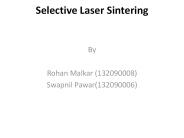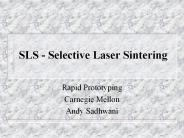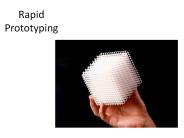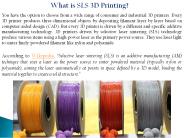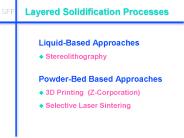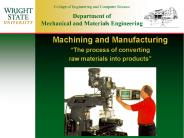Selective Laser Sintering PowerPoint PPT Presentations
All Time
Recommended
Selective Laser Sintering ... The roller pushes the material on the built platform and the process is repeated again an again. ... Aerospace. Automotive.
| PowerPoint PPT presentation | free to download
SELECTIVE LASER SINTERING (SLS) SLS History Selective Laser Sintering was developed by the University of Texas in 1987. Commercialized by DTM Corporation, a ...
| PowerPoint PPT presentation | free to download
Filetype .stl' used - structural triangle language ... Nylon-11 with 50% Glass Reinforcement. Nylon-12. Finer Surface Quality but lower elasticity ...
| PowerPoint PPT presentation | free to download
Selective Laser Sintering Selective laser sintering is an additive rapid prototyping technique that uses a high power laser to fuse small particles of thermoplastic ...
| PowerPoint PPT presentation | free to view
Selective Laser Sintering is the ability to manufacture a three-dimensional functional product for any complicated shape using metal powder. Innovae3d provides the best Selective Laser Sintering Services.
| PowerPoint PPT presentation | free to download
Selective Laser Sintering Equipment Market research report categorizes global market by Material (Metal, and Nylon), Application (Tooling, heavy equipment & machinery, and Robotics), Industry (Consumer Goods, Automotive, Medical Devices), Laser Type, and Geography.
| PowerPoint PPT presentation | free to download
The SLS equipment market is estimated at USD 339.5 million in 2018 and is projected to reach USD 947.4 million by 2023, for both equipment and material, growing at a CAGR of 22.8% from 2018 to 2023, whereas the market for equipment, inclusive of SLS and DMLS, is projected to grow at a CAGR of 27.5% during the forecast period. • Download PDF Brochure:- https://www.marketsandmarkets.com/pdfdownload.asp?id=27853684 Major players in the SLS equipment market include 3D Systems Corporation (US), EOS GmbH (Germany), Farsoon Technologies (China), Prodways Group (France), Formlabs, Inc. (US), Sinterit sp. z o.o. (Poland), Renishaw Plc. (UK), Sintratec AG (Switzerland), Sharebot S.r.l. (Italy), Natural Robotics (Spain), Ricoh Company, Ltd. (Tokyo), Z Rapid Tech (China), Concept Laser GmbH (Germany), Aerosint (Belgium), XYZ Printing, Inc. (Taiwan), Dynamic Tools (Spain), Aspect Inc (Japan), and Red Rock SLS (Russia).
| PowerPoint PPT presentation | free to download
All-inkjet-printed flexible electronics fabrication on a polymer substrate by low-temperature high-resolution selective laser sintering of metal nanoparticles
| PowerPoint PPT presentation | free to download
SISMA's My Sint 100 is an innovative machine for selective laser melting of metal powders designed for goldsmiths.
| PowerPoint PPT presentation | free to download
3. / SLS Selective Laser Sintering 7-7 ...
| PowerPoint PPT presentation | free to view
Stereolithography (SL) Macchina SL 3D System SLA 7000 Laser: He-Cd Lunghezza d onda: 0,325 mm Potenza: ... (SGC) Selective Laser Sintering (SLS) ...
| PowerPoint PPT presentation | free to download
Selective Laser Sintering. Selective Laser Sintering (SLS , registered trademark by DTM of Austin, Texas, USA) is a process that was patented in 1989 by Carl ...
| PowerPoint PPT presentation | free to download
Selective Laser Sintering. Developed at University of Texas, commercialized by DTM corporation. ... Laser used to fuse or 'sinter' layer onto part. ...
| PowerPoint PPT presentation | free to view
TBRC global 3d printing materials market report includes polymers, metal, ceramic, fused deposition modeling (fdm), selective laser sintering (sls), stereolithography https://bit.ly/3AdawtL
| PowerPoint PPT presentation | free to download
... (PD-AFO) fit customization and manufacture framework: medial aspect of subsequent PD-AFO fabricated using selective laser sintering. * Figure 7.
| PowerPoint PPT presentation | free to view
Fabrication of a Thermally Gradient Fin. Adam Schneider (Dr. Kumpaty) STAINLESS STEEL FIN VIA SELECTIVE LASER MELTING. Selective Laser Sintering Prototype ...
| PowerPoint PPT presentation | free to view
Rapid Prototyping powder polymers ... Platform moves up into position to ... accuracy is slightly less than that of Stereolithography and Selective laser sintering ...
| PowerPoint PPT presentation | free to download
Unlike other widely-used 3D printing technologies, selective laser sintering (SLS) forms solid three-dimensional items from powdered materials. It uses a powerful laser as the power source to form the model by sintering and fusing the particles of powdered materials selectively. But the best SLS 3D printing companies differ from each other in many aspects, including machines, filaments, and services. https://www.aurum3d.com/3d-printing-services/
| PowerPoint PPT presentation | free to download
2) Selective Laser Sintering (SLS): The most advanced laser fusion ... the surface defining the regions to sinter, fusing the polymer and bonding the particles. ...
| PowerPoint PPT presentation | free to view
Figure 6. Schematic indicating build orientations and positions of half-scale passive-dynamic ankle-foot orthoses within selective laser sintering build volume.
| PowerPoint PPT presentation | free to view
Selective Laser Sintering (SLS) 1. Deposit layer of powder on ... 6. Bake model in oven to sinter (melting point d)* 7. Diffuse lower MP metal to fill pores ...
| PowerPoint PPT presentation | free to view
3D printing technologies differ from each other in many categories including materials or filaments. Selective Laser Sintering (SLS), unlike other widely used 3D printing technology, produces product prototypes and end parts by sintering thermoplastic powder. An SLS printer forms solid parts by sintering and fusing thermoplastic powder using a high-power laser. The thermoplastic powder makes SLS 3D printing technology effective in producing parts with higher toughness, impact strength, and dimensional accuracy. https://www.aurum3d.com/sls-3d-printing-services/
| PowerPoint PPT presentation | free to download
Build parts in layers based on CAD model. SLA=Stereolithogrpahy Apparatus SLS=Selective Laser Sintering 3D Printing LOM=Laminated Object Manufacturing Others every ...
| PowerPoint PPT presentation | free to download
You can produce solid three-dimensional objects from digital three-dimensional models using various 3D printing technologies. Each 3D printing technology produces the three-dimensional object physically by processing and curing the filament in a specific way. Selective laser sintering (SLS) 3D printing technology forms the solid structure by sintering powdered materials using a high-power laser. https://www.aurum3d.com/blog/sls-3d-printing-process/
| PowerPoint PPT presentation | free to download
Global 3d Printing Market by Component (Hardware, Services, Software) by Technology (Stereolithography, Fused Deposition Modelling (Fdm), Selective Laser Sintering (Sls), Direct Metal Laser Sintering (Dmls), Inkjet Printing, Electron Beam Melting, Laser Metal Deposition, Digital Light Processing, Laminated Object Manufacturing) by Industry Vertical (Automotive, Aerospace & Defense, Healthcare, Consumer Electronics, Industrial Products, Power & Energy, Other Industry Verticals) by Application (Prototyping, Tooling, Functional Part) by Material Type (Plastic, Photopolymer, Metals and Metal Alloys, Ceramics, Other Material Types) by Geography.
| PowerPoint PPT presentation | free to download
paper, wax, or plastic to create a solid object. ... Stereo Lithography (SLA) Laminated Object Manufacture (LOM) Selective Laser Sintering (SLS) ...
| PowerPoint PPT presentation | free to view
Review of many of the major applications of lasers (and a few daft ones) ... components prior to welding and PCB's and component leads prior to soldering. ...
| PowerPoint PPT presentation | free to view
Accessing the world of 3D printing is getting easier and easier. This is due to the fact that printers designed for both pros and enthusiasts are readily available. One of the difficulties they may encounter initially, though, is the expense. The cost of a 3D printer can vary greatly, ranging from a few hundred to several thousand dollars. So, how do you sort through this selection and pick a printer that fits your requirements (and budget)? The cost of a 3D printer is determined by a number of factors: Technology The most popular technique utilized in consumer-grade printers, fused deposition modeling (FDM), enables lower costs. Other technologies, such Selective Laser Sintering (SLS) and Stereolithography (SLA), offer greater precision and a wider
| PowerPoint PPT presentation | free to download
Global 3D printing market is set to witness seven-fold expansion, with revenues projected to see a double-digit CAGR during 2019-2029. As projected by a new report of Future Market Insights (FMI), leading market players are investing in adoption of vat polymerization and selective laser sintering processes in a bid to reduce processing time and achieve greater accuracy.
| PowerPoint PPT presentation | free to view
... (Selected Laser Sintering SLS (3) (3) 2 ...
| PowerPoint PPT presentation | free to view
Laser beam can very easily be focused using optical lenses as their wavelength ranges from half micron to around 70 microns. ... Welding . Cladding . Alloying .
| PowerPoint PPT presentation | free to download
In 3D printing plastic materials, Injection molding is a technique that has been widely practiced in making different objects. Earlier mud, metals, etc. were the materials molded for making tools and utensils and using very basic techniques. But the technology has led to intervention of modern techniques which are used to mold the materials such as plastics, biomaterials, polymers and thus the term 3D printing. The printing materials exist in 3 forms i.e. filament, powder and liquid and printing techniques such as fused deposition modeling, stereo lithography, selective laser sintering (SLS), Poly jet/ink jet 3D printing , binder jetting, etc. are applied to model various objects of the material. The printed objects are used in various end user industries for manufacturing, producing full-color concept models, architectural models, and visual arts projects.
| PowerPoint PPT presentation | free to download
This article covers all the details about Co2 lasers. It explains about its working, specifications, and the uses. Check out this article to learn more...
| PowerPoint PPT presentation | free to download
SISMA Group Presents Laser Cutting Machine for the Jewellery industries. Jewelry making is very much crucial work and latest laser machines from SISMA S.p.a. Is based in Piovene Rocchette, Italy Makes it very easy and accurate.
| PowerPoint PPT presentation | free to download
... LA PROTOTIPAZIONE RAPIDA Laser sintering: un processo che sfrutta la sinterizzazione di POLVERI, siano esse metalliche, polimeriche o ceramiche.
| PowerPoint PPT presentation | free to download
Laser - Sintering Metal pou vaj se speci ln vyvinut kovov pr ky. Sou sti jsou pevn a mechanicky odoln formy pro plastov v lisky ...
| PowerPoint PPT presentation | free to download
Innovae3d provides Metal 3D Printing and manufacturing services. In that are include design, development, analysis, printing and post-processing. Metal 3D Printing is a laser-based technology that uses powdered metals. Powdered metal is spread across the entire build platform and selectively melted to previous layers.
| PowerPoint PPT presentation | free to download
SLS 3D printing is often described as a modern additive manufacturing technology. But the 3D printing technology is currently used widely by manufacturers and 3D printing service providers for the purpose of low-volume production of components and rapid prototyping. This 3D printing technology produces solid items based on the powder sintering principle. An SLS 3D printer consolidates small particles of the powdered filament using a high-powerful laser. The laser produces a mass by sintering the powdered material based on the CAD. The 3D printer preheats the filament to a temperature that is below the melting point. https://www.aurum3d.com/sls-3d-printing-services/
| PowerPoint PPT presentation | free to download
While creating a part or prototype, you have the option to choose from several additive manufacturing technologies. Each additive manufacturing technique produces the part or prototype using fusing specific materials or filaments. Direct metal laser sintering (DMLS) is a widely used 3D printing technology that produces fully-functional production parts and prototypes using metal materials. We are amongst the major 3D printing companies in Bangalore, India. https://www.aurum3d.com/blog/dmls-advantages-disadvantages/
| PowerPoint PPT presentation | free to download
2 sinter plants 6,0 Mt/y. hot strip mill 5,5 Mt/y. laser-welded blanks. Tailor Steel (Gent Genk) : 7,5 x 106 pieces/y. 2 blast furnaces 3,9 Mt/y 4,5 Mt/y. coke ...
| PowerPoint PPT presentation | free to view
EMS centres on the study of the structure & physical properties of ... Deposition - electroplating; chemical vapour deposition; sputtering & laser ablation ...
| PowerPoint PPT presentation | free to view
undeviated ray. Diffracted ray. Refracted ray. Reflected ray. Transmitted after. internal reflection. Transmitted ray. Laser Light Scattering ...
| PowerPoint PPT presentation | free to view
Lab environment necessary (gasses!) Needs trained operator. Laser ... Color print head with: Cyan, Yellow, Magenta, Black, and Neutral. Smaller build area. ...
| PowerPoint PPT presentation | free to download
Fe-Cu or Stainless Steel-Cu powders Sintering is performed in an inert gas environment to prevent oxidation of metal ... 05 mm Non-dipping recoat system: ...
| PowerPoint PPT presentation | free to download
Instead it depends on sputtering and therefore differs fundamentally from electron- or laser-beam ... The drilling process is characterized by solid work ...
| PowerPoint PPT presentation | free to download
M. Meyyappan Electrical interconnects Copper, Tungsten Photonics (Q-switch, blue-green laser diode, blue-UV photodetector) Zinc Selenide Electronics, optoelectronics ...
| PowerPoint PPT presentation | free to view
Figure 11.1 (a) Examples of typical parts made by powder-metallurgy ... Source: Courtesy of Zenith Sintered Products, Inc., Milwaukee, Wisconsin. (a) (b) (c) ...
| PowerPoint PPT presentation | free to download
DEVELOP TEXT MINING TO SUPPORT PROGRAM OFFICERS. THREE DISTINCT PHASES ... or roller* or rolling or scour* or seals or seismic or siltation or sintering or ...
| PowerPoint PPT presentation | free to view
The Metal 3D printing is a revolution in the world of manufacturing and its significance is rising. With the help of 3D CAD technology, metal 3D printing techniques take help of binders, lasers, and heated nozzles to develop things that are robust and with minute internal features.
| PowerPoint PPT presentation | free to download
There are lots of different technologies has been used for the sake of 3D printing and 3D printing is developed by the virtue of this latest enhancements. FDM or We can say that Fused deposition Modeling is one of the most used technology thereby.
| PowerPoint PPT presentation | free to download
Machining and Manufacturing The process of converting raw materials into products Overview Machining Welding Molding/Casting Rapid Prototyping Machining ...
| PowerPoint PPT presentation | free to download
raw materials into products' College of Engineering and ... Mechanical and Materials Engineering. Rapid Prototyping: Creating Real Objects from AutoCad ...
| PowerPoint PPT presentation | free to download
3D Metal Printing is used in medical and dental industry, automotive industry, etc. There are different types of methods which are used for metal printing. They are SLA, DLP, FDM, SLM, etc. The presentation gives the detailed view of all of these methods of 3D printing.
| PowerPoint PPT presentation | free to download
Title: No Slide Title Author: x Last modified by: HANDAN Created Date: 5/26/1999 1:47:10 PM Document presentation format: On-screen Show Company: xx
| PowerPoint PPT presentation | free to view
The 3D printing medical devices market is projected to reach US$ 6,583.50 million by 2028 from US$ 2,123.11 million in 2021; it is estimated to grow at a CAGR of 17.5% from 2021 to 2028.
| PowerPoint PPT presentation | free to download
Arte Tooling provides best rapid prototyping services in china. Our rapid prototyping services include some more techniques like Additive Manufacturing, SLA/SLS Manufacturing, CNC prototyping and Polyurethane Vacuum Casting. http://www.artetooling.net/
| PowerPoint PPT presentation | free to download

